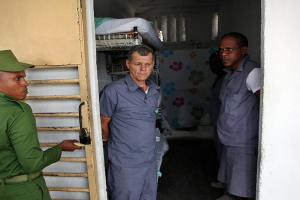
It happened in 2005. The prisoners were killed while guards remained impassive. A witness recounts the events.
HAVANA, Cuba – A riot that caused several deaths and dozens of injuries occurred on April 5, 2005, at the the maximum security Havana prison, Combinado del Este. Yoslan Diaz Quinones, recently released from prison after serving more than ten years in the prison, witnessed these events and agreed to describe them for Cubanet’s readers.
“The riot began because the inmate José Antonio Pavón Bonilla, one of the leading members of the cult called ’Just as I Am’ was notified that he would be transferred to a prison in Villa Clara. He claimed he could not go to that place because he had several enemies there. Furthermore, also in that prison, years ago, José had organized a riot.
“His reasons were useless. They told him the decision was made and there would be no reversing it.Then, at the first opportunity, he called the jailer who had keys to several of the cell blocks. He managed to tie him up, get the keys off him, and started to let everyone out.
“There were about 200 prisoners in each block. The only cell that Bonilla didn’t open was that of Abnoli, the Bakun Kere. He is a dangerous murderer. Abnoli screamed obscenity and said if he didn’t open the bars he would kill him. Meanwhile, others who were with him asked him not to release the Devil. But one of them called Chiqui, grabbed the keys and let him out.
“From there everything changes. They said everyone went to the dining room with their mats and protested José’s transfer, but they also immediately started to protest against Lt. Col. Carlos Alberto Quintana, then head of the prison, and yelling things against Fidel and Raul Castro. continue reading
“José Antonio Pavón Bonilla did not want to push things to such extremes, and told Abnoli he had to open the doors because there were people burning and choking, but Abnoli said that he didn’t care because they weren’t his family. Then someone, I don’t know who, gave the order to collect all the knives,the shivs, and every kind of weapon they had.
“After this they decided to open the doors. But there was another order: those who were leading the riot had to put themselves at the front and mercilessly stab everyone who came out. Neither the authorities nor anyone tried to control that frenzy.
“After three hours the riot squad appeared, they said it was Raul Castro’s Command One, and using rubber bullets and other weapons they were able to stop it.”
According to the testimony of Yoslan Díaz Quiñones, there were five dead in the revolt and some 80 wounded, 29 of them seriously.
josefornaris@gmail.com
Editorial Note:
These images of prisoners in the Combinado del Este prison were taken by the EFE and AFP agencies during a visit allowed by the government in April 2013. The photo report, published ihere, said there is no overcrowding and fighting among inmates is rare.
The head of prison health, Kervin Morales, said that knife crime among prisoners is rare (“we almost never have emergencies”) and there are no HIV infections in prisons. However, he admitted that from time to time there are hunger strikes.
It is also said in the report that prisoners work in an area outside the double fence, where there is a workshop for crashed cars, whose parts are sold . In this work, EFE said, outside mechanics and inmates work together, earning the ‘results.’ Some get between 2,000 pesos and 3,000 Cuban pesos per month (83 to 125 U.S. dollars), three to five times the national average salary.
They saw the face of Combinado del Este that the govenment wants to show, and some of the media bought it.
Cubanet , March 5, 2014, Jose Antonio Fornaris

